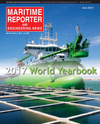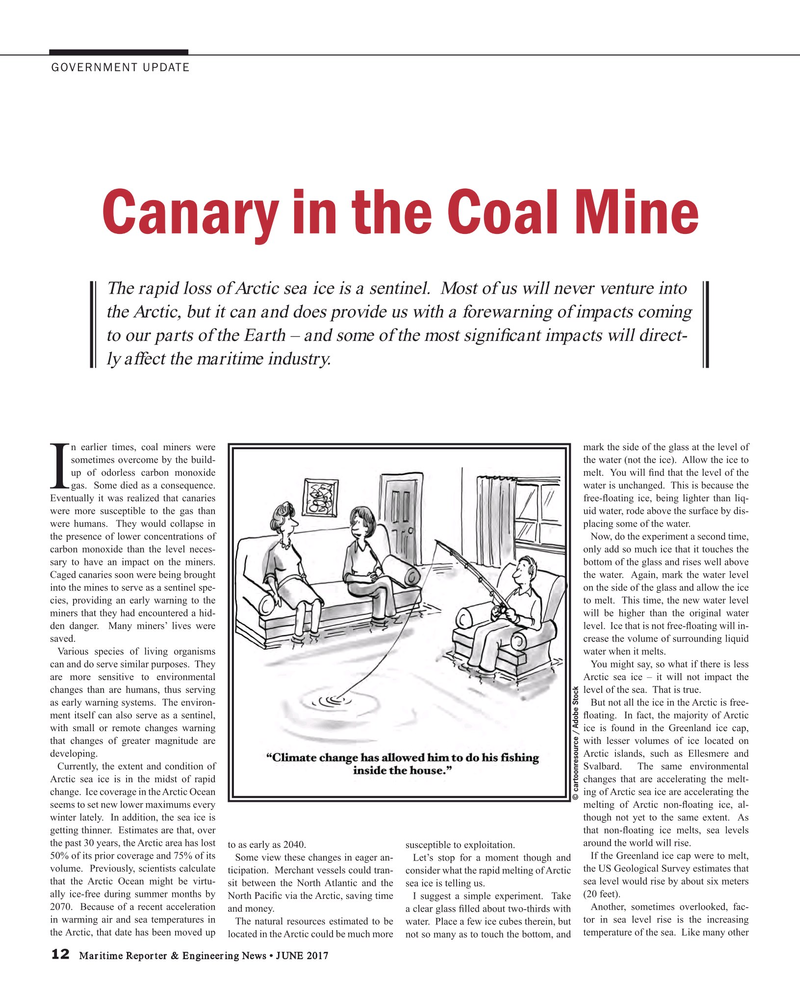
Page 12: of Maritime Reporter Magazine (June 2017)
U.S. Navy Quarterly
Read this page in Pdf, Flash or Html5 edition of June 2017 Maritime Reporter Magazine
GOVERNMENT UPDATE
Canary in the Coal Mine
The rapid loss of Arctic sea ice is a sentinel. Most of us will never venture into the Arctic, but it can and does provide us with a forewarning of impacts coming to our parts of the Earth – and some of the most signi? cant impacts will direct- ly affect the maritime industry.
n earlier times, coal miners were mark the side of the glass at the level of sometimes overcome by the build- the water (not the ice). Allow the ice to up of odorless carbon monoxide melt. You will ? nd that the level of the
Igas. Some died as a consequence. water is unchanged. This is because the
Eventually it was realized that canaries free-? oating ice, being lighter than liq- were more susceptible to the gas than uid water, rode above the surface by dis- were humans. They would collapse in placing some of the water.
the presence of lower concentrations of Now, do the experiment a second time, carbon monoxide than the level neces- only add so much ice that it touches the sary to have an impact on the miners. bottom of the glass and rises well above
Caged canaries soon were being brought the water. Again, mark the water level into the mines to serve as a sentinel spe- on the side of the glass and allow the ice cies, providing an early warning to the to melt. This time, the new water level miners that they had encountered a hid- will be higher than the original water den danger. Many miners’ lives were level. Ice that is not free-? oating will in- saved. crease the volume of surrounding liquid
Various species of living organisms water when it melts.
can and do serve similar purposes. They You might say, so what if there is less are more sensitive to environmental Arctic sea ice – it will not impact the changes than are humans, thus serving level of the sea. That is true.
as early warning systems. The environ- But not all the ice in the Arctic is free- ment itself can also serve as a sentinel, ? oating. In fact, the majority of Arctic with small or remote changes warning ice is found in the Greenland ice cap, that changes of greater magnitude are with lesser volumes of ice located on developing. Arctic islands, such as Ellesmere and
Currently, the extent and condition of Svalbard. The same environmental
Arctic sea ice is in the midst of rapid changes that are accelerating the melt- change. Ice coverage in the Arctic Ocean ing of Arctic sea ice are accelerating the © cartoonresource / Adobe Stock seems to set new lower maximums every melting of Arctic non-? oating ice, al- winter lately. In addition, the sea ice is though not yet to the same extent. As getting thinner. Estimates are that, over that non-? oating ice melts, sea levels the past 30 years, the Arctic area has lost to as early as 2040. susceptible to exploitation.
around the world will rise. 50% of its prior coverage and 75% of its If the Greenland ice cap were to melt,
Some view these changes in eager an- Let’s stop for a moment though and volume. Previously, scientists calculate ticipation. Merchant vessels could tran- consider what the rapid melting of Arctic the US Geological Survey estimates that that the Arctic Ocean might be virtu- sea level would rise by about six meters sit between the North Atlantic and the sea ice is telling us.
ally ice-free during summer months by North Paci? c via the Arctic, saving time
I suggest a simple experiment. Take (20 feet).
2070. Because of a recent acceleration and money. a clear glass ? lled about two-thirds with
Another, sometimes overlooked, fac- in warming air and sea temperatures in The natural resources estimated to be water. Place a few ice cubes therein, but tor in sea level rise is the increasing the Arctic, that date has been moved up located in the Arctic could be much more not so many as to touch the bottom, and temperature of the sea. Like many other 12 Maritime Reporter & Engineering News • JUNE 2017
MR #6 (10-17).indd 12 MR #6 (10-17).indd 12 6/7/2017 9:35:20 AM6/7/2017 9:35:20 AM

 11
11

 13
13
